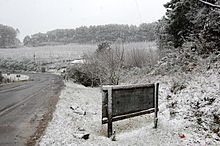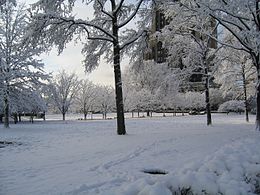
Winter is the coldest season of the year in polar and temperate zones (winter does not occur in most of the tropical zone). It occurs after autumn and before spring in each year. Winter is caused by the axis of the Earth in that hemisphere being oriented away from the Sun. Different cultures define different dates as the start of winter, and some use a definition based on weather. When it is winter in the Northern Hemisphere, it is summer in the Southern Hemisphere, and vice versa. In many regions, winter is associated with snow and freezing temperatures. The moment of winter solstice is when the sun's elevation with respect to the North or South Pole is at its most negative value (that is, the sun is at its farthest below the horizon as measured from the pole). The day on which this occurs has the shortest day and the longest night, with day length increasing and night length decreasing as the season progresses after the solstice. The earliest sunset and latest sunrise dates outside the polar regions differ from the date of the winter solstice, however, and these depend on latitude, due to the variation in the solar day throughout the year caused by the Earth's elliptical orbit (see earliest and latest sunrise and sunset).
Screenplay
The English word "winter" comes from the Proto-Indo-European root "wend," relating to water.
The tilt of the Earth's axis relative to its orbital plane plays a large role in the formation of weather. The Earth is tilted at an angle of 23.44° to the plane of its orbit, causing different latitudes to directly face the Sun as the Earth moves through its orbit. This variation brings about seasons. When it is winter in the Northern Hemisphere, the Southern Hemisphere faces the Sun more directly and thus experiences warmer temperatures than the Northern Hemisphere. Conversely, winter in the Southern Hemisphere occurs when the Northern Hemisphere is tilted more toward the Sun. From the perspective of an observer on the Earth, the winter Sun has a lower maximum altitude in the sky than the summer Sun.
During winter in either hemisphere, the lower altitude of the Sun causes the sunlight to hit that hemisphere at an oblique angle. In regions experiencing winter, the same amount of solar radiation is spread out over a larger area. This effect is compounded by the larger distance that the light must travel through the atmosphere, allowing the atmosphere to dissipate more heat. Compared with these effects, the changes in the distance of the earth from the sun are negligible.
The manifestation of the meteorological winter (freezing temperatures) in the northerly snow–prone parallels is highly variable depending on elevation, position versus marine winds and the amount of precipitation. A case in point is Canada, a country normally associated with tough winters. Winnipeg on the Great Plains at a relative distance from large bodies of water has a January high of ?11.3 °C (11.7 °F) and a low of ?21.4 °C (?6.5 °F). In comparison, Vancouver on the coast with a marine influence from moderating Pacific winds has a January low of 1.4 °C (34.5 °F) with days well above freezing at 6.9 °C (44.4 °F). Both areas are on the 49th parallel north and in the same western half of the continent. A similar effect, although with less extreme differentials, is found in Europe where in spite of the northerly latitude of the islands, the British Isles has not a single non-mountain weather station with a below-freezing mean temperature.
Meteorological reckoning is the method of measuring the winter season used by meteorologists based on "sensible weather patterns" for record keeping purposes, so the start of meteorological winter varies with latitude. Winter is often defined by meteorologists to be the three calendar months with the lowest average temperatures. This corresponds to the months of December, January and February in the Northern Hemisphere, and June, July and August in the Southern Hemisphere. The coldest average temperatures of the season are typically experienced in January or February in the Northern Hemisphere and in June, July or August in the Southern Hemisphere. Nighttime predominates in the winter season, and in some regions winter has the highest rate of precipitation as well as prolonged dampness because of permanent snow cover or high precipitation rates coupled with low temperatures, precluding evaporation. Blizzards often develop and cause many transportation delays. Diamond dust, also known as ice needles or ice crystals, forms at temperatures approaching ?40 °C (?40 °F) due to air with slightly higher moisture from aloft mixing with colder, surface based air. They are made of simple ice crystals that are hexagonal in shape. The Swedish meteorological institute (SMHI) define winter as when the daily mean temperatures go below 0 °C (32 °F) for five consecutive days. According to the SMHI, winter in Scandinavia is more pronounced when Atlantic low-pressure systems take more southerly and northerly routes, leaving the path open for high-pressure systems to come in and cold temperatures to occur. As a result, the coldest January on record in 1987 was also the sunniest in Stockholm.
Accumulations of snow and ice are commonly associated with winter in the Northern Hemisphere, due to the large land masses there. In the Southern Hemisphere, the more maritime climate and the relative lack of land south of 40°S makes the winters milder; thus, snow and ice are less common in inhabited regions of the Southern Hemisphere. In this region, snow occurs every year in elevated regions such as the Andes, the Great Dividing Range in Australia, and the mountains of New Zealand, and also occurs in the southerly Patagonia region of South Argentina. Snow occurs year-round in Antarctica.
In the Northern Hemisphere, some authorities define the period of winter based on astronomical fixed points (i.e. based solely on the position of the Earth in its orbit around the sun), regardless of weather conditions. In one version of this definition, winter begins at the winter solstice and ends at the vernal equinox. These dates are somewhat later than those used to define the beginning and end of the meteorological winter – usually considered to span the entirety of December, January, and February in the Northern Hemisphere and June, July, and August in the Southern.
Astronomically, the winter solstice, being the day of the year which has fewest hours of daylight, ought to be in the middle of the season, but seasonal lag means that the coldest period normally follows the solstice by a few weeks. In some cultures, the season is regarded as beginning at the solstice and ending on the following equinox – in the Northern Hemisphere, depending on the year, this corresponds to the period between 21 or 22 December and 19, 20 or 21 March.
In the UK, meteorologists consider winter to be the three coldest months of December, January and February. In Scandinavia, winter in one tradition begins on 14 October and ends on the last day of February. In Russia, currently calendar winter starts on 1 December and lasts through to the end of February, though traditionally it was reckoned from Christmas (25 December in the Julian calendar, or 7 January in the Gregorian) until the Annunciation (25 March in Julian). In many countries in the Southern Hemisphere, including Australia, New Zealand and South Africa, winter begins on 1 June and ends on 31 August. In Celtic nations such as Ireland (using the Irish calendar) and in Scandinavia, the winter solstice is traditionally considered as midwinter, with the winter season beginning 1 November, on All Hallows, or Samhain. Winter ends and spring begins on Imbolc, or Candlemas, which is 1 or 2 February. This system of seasons is based on the length of days exclusively. (The three-month period of the shortest days and weakest solar radiation occurs during November, December and January in the Northern Hemisphere and May, June and July in the Southern Hemisphere.)
Also, many mainland European countries tended to recognize Martinmas or St. Martin's Day (11 November), as the first calendar day of winter. The day falls at the midpoint between the old Julian equinox and solstice dates. Also, Valentine's Day (14 February) is recognized by some countries as heralding the first rites of spring, such as flowers blooming.
In Chinese astronomy and other East Asian calendars, winter is taken to commence on or around 7 November, with the Jiéqì (known as ?? lì d?ng—literally, "establishment of winter").
The three-month period associated with the coldest average temperatures typically begins somewhere in late November or early December in the Northern Hemisphere and lasts through late February or early March. This "thermological winter" is earlier than the solstice delimited definition, but later than the daylight (Celtic) definition. Depending on seasonal lag, this period will vary between climatic regions.
Cultural influences such as Christmas creep may have led to the winter season being perceived as beginning earlier in recent years, although high latitude countries like Canada are usually well into their real winters before the December solstice.
Since by almost all definitions valid for the Northern Hemisphere, winter spans 31 December and 1 January, the season is split across years, just like summer in the Southern Hemisphere. Each calendar year includes parts of two winters. This causes ambiguity in associating a winter with a particular year, e.g. "Winter 2018". Solutions for this problem include naming both years, e.g. "Winter 18/19", or settling on the year the season starts in or on the year most of its days belong to, which is the later year for most definitions.
Ecological reckoning of winter differs from calendar-based by avoiding the use of fixed dates. It is one of six seasons recognized by most ecologists who customarily use the term hibernal for this period of the year (the other ecological seasons being prevernal, vernal, estival, serotinal, and autumnal). The hibernal season coincides with the main period of biological dormancy each year whose dates vary according to local and regional climates in temperate zones of the Earth. The appearance of flowering plants like the crocus can mark the change from ecological winter to the prevernal season as early as late January in mild temperate climates.
To survive the harshness of winter, m
Watch movie Wintertime online on Amazon
Watch movie Wintertime online
Watch The Movie On PrimeHera Pheri Full HD Movie Download

99.9 FM-Nothing is 100% Full HD Movie Download

Dil Hi To Hai Full HD Movie Download

Bhagyawan Full HD Movie Download

Narad Muni Full HD Movie Download

Paisa Ya Pyar Full HD Movie Download

Dharam Yudh (1988) Full HD Movie Download
.jpg)
Ghar Ghar Ki Kahani (1988) Full HD Movie Download
.jpg)
Aastha: In The Prison Of Spring Full HD Movie Download

Nasha Jism Ka Full HD Movie Download

7 Khoon Maaf Full HD Movie Download

Khurchi Samrat Full HD Movie Download

Bhagvat Geeta Full HD Movie Download

Ee Tharam Nehru Full HD Movie Download

Swimming Pool Full HD Movie Download

Moral Stories Full HD Movie Download

Manikya Chempazhukka Full HD Movie Download

Maarina Manishi Full HD Movie Download

Evarunenu Full HD Movie Download

Karthika Deepam Full HD Movie Download

Tiger Ramadu Full HD Movie Download

Download latest Movie from bollywood
- 1> baaghi 3
- 2> THE SKY IS PINK MOVIE FULL STORY AND REVIEW
- 3> Luka Chuppi
- 4> TO ALL THE BOYS I’VE LOVED BEFORE
- 5> Kabir Singh
- 6> Street Dancer 3D
- 7> Simmba
- 8> Gone Girl
- 9> The Girl Who Lived
- 10> Ludo
- 11> DILWALE DULHANIA LE JAYENGE
- 12> GUILTY
- 13> The Godfather
- 14> Adventures of Rusty
- 15> Sooryavanshi
- 16> Satyameva Jayate 2
- 17> Thappad
- 18> Bhool Bhulaiyaa 2
- 19> KGFChapter 2
- 20> Mardaani 2
- 21> Pinjar
- 22> Shivaji maharaj
- 23> Ek Villian 2
- 24> Hungama 2
- 25> Divergent
- 26> Mumbai Saga
- 27> The Internship
- 28> HIT (telugu)
- 29> Panga
- 30> The perfect date
- 31> 16 December
- 32> Gopala Gopala (Telugu)
- 33> Brahmastra
- 34> Gangubai Kathiawadi
- 35> Manmadhudu
- 36> Nenu local
- 37> Mahanati
- 38> Shatamanam bavathi
- 39> Lagaan
- 40> After
- 41> MOM
- 42> Shamshera
- 43> Raguvaran BTech
- 44> Khakee
- 45> The villain
- 46> OM
- 47> Mr. perfect
- 48> Bueatifull mind
- 49> Hichki
- 50> Gabbar Singh
- 51> Jogi
- 52> Before Sunrise
- 53> Before Sunset
- 54> Before Midnight
- 55> The Big Bull
- 56> Top Gun: Maverick
- 57> The Purge
- 58> The Sky is Pink
- 59> Laxmmi Bomb
- 60> Sadak 2
- 61> Sufna
- 62> Prithviraj
- 63> PK
- 64> Coolie No 1(2020)
- 65> Black Widow
- 66> Dear Zindagi
- 67> Dil Bechara
- 68> PHIR HERA PHERI
- 69> WAR
- 70> Dostana
- 71> RRR: Roudram Ranam Rudhiram
- 72> Maidan
- 73> Dabbang 3
- 74> Chhalaang
- 75> life as we know it
- 76> SherShaah
- 77> Sandeep Aur Pinky Faraar
- 78> Event Horizon
- 79> 83
- 80> Radhe: Your Most Wanted Bhai
- 81> Gunjan Saxena: The Kargil Girl
- 82> Mr India
- 83> Vivah
- 84> Anokha Bandhan
- 85> Ghost
- 86> Bhoot: Part One - The Haunted Ship
- 87> Haseen Dilruba
- 88> Laal Singh Chaddha
- 89> Qismat
- 90> Rajput
- 91> Drive
- 92> Dil Chahta Hai
- 93> Dil Ki Baazi
- 94> Dil Ka Rishta
- 95> Teesri Manzil
- 96> Dil
- 97> Love Aaj Kal
- 98> Khaali Peeli
- 99> Bunty Aur Babli 2
- 100> Atrangi Re
- 101> Gulabo Sitabo
- 102> Jodi
- 103> Suraj Pe Mangal Bhari
- 104> Deewana
- 105> Attack
- 106> Sardar Udham Singh
- 107> Toofan
- 108> THE LOVEBIRDS
- 109> Jersey
- 110> Ginny Weds Sunny
- 111> Thalaivi
- 112> Shiddat
- 113> Angels vs Zombies
- 114> Koi Mil Gya
- 115> Thank God
- 116> Bhuj: The Pride of India
- 117> Hum Aapke Hain Kaun
- 118> The Platform
- 119> Bird Box
- 120> Roohi Afzana
- 121> Torbaaz
- 122> Nikamma
- 123> World War Z
- 124> Extraction
- 125> Train to Busan
- 126> Life of Pi
- 127> SHAADI MEIN JROOR AANA
- 128> Himmat Aur Mehnat
- 129> To All The Boys: P.S. I Still Love You
- 130> Mimi
- 131> Good Newwz
- 132> Shubh Mangal Zyada Saavdhan
- 133> Raabta
- 134> Harry Potter and the Philosopher's Stone
- 135> Harry Potter and the Chamber of Secrets
- 136> Chhapaak
- 137> War of the Worlds
- 138> Harry Potter and the Prisoner of Azkaban
- 139> Harry Potter and the Goblet of Fire
- 140> MURDER MYSTERY
- 141> Shakuntala Devi
- 142> Bachchan Pandey
- 143> Jayeshbhai Jordar
- 144> Sheer Qorma
- 145> Saina
- 146> 'O' Pushpa I hate tears
- 147> Kedarnath
- 148> MS Dhoni The Untold Story
- 149> Chhichhore
- 150> Badhaai Ho
- 151> Unstoppable
- 152> Oz the Great And Powerful
- 153> The Girl on the Train
- 154> Haathi Mere Saathi 2020
- 155> The Conjuring: The Devil Made Me Do It
- 156> Gandhi Se Pehle Gandhi
- 157> The Song of Scorpions
- 158> Srimanthudu
- 159> Hello Guru Prema Kosame
- 160> Beauty and The Beast
- 161> Black Panther
- 162> Charlie and the Chocolate Factory
- 163> Bole Chudiyan
- 164> Fidaa
- 165> Duvvada Jagannadham
- 166> Bruce Lee: The Fighter
- 167> Hyper
- 168> Yaara
- 169> Red (2020)
- 170> Shivam
- 171> That Is Mahalakshmi
- 172> Nishabdham
- 173> Aashram 2020 web series
- 174> Laxmii
- 175> Mismatched
- 176> STUDENT OF THE YEAR 2
- 177> NAIL POLISH
- 178> Ramprasad Ki Tehrvi
- 179> KAAGAZ
- 180> 12 o Clock
- 181> The Power
- 182> bolo hau
- 183> Tribhanga
- 184> JAMUN
- 185> Madam Chief Minister
- 186> Maasaab
- 187> Aadhaar
- 188> Tanhaji
- 189> Bhaagi 3
- 190> Bhootnath
- 191> MALANG
- 192> Jai Mummy Di
- 193> Haathi Mere Saathi 2021
- 194> Shakeela
- 195> Unpaused
- 196> Annayya
- 197> Vamsoddharakudu
- 198> Mrugaraju
- 199> Narasimha Naidu
- 200> Sankranti
- 201> Manasu Maata Vinadhu
- 202> Anjaane
- 203> Apaharan
- 204> Bachke Rehna Re Baba
- 205> Bewafaa
- 206> Roohi
- 207> Radhe
- 208> Zindagi Khoobsoorat Hai
- 209> Yeh Mohabbat Hai
- 210> Yeh Kya Ho Raha Hai?
- 211> The Tomorrow War
- 212> DehradunDiary
- 213> Meri Shaadi Karaoo
- 214> Matruu Ki Bijlee Ka Mandola
- 215> No One Killed Jesica
- 216> Aag Ka Goola
- 217> Eight Million Dollars
- 218> Three Hundred
- 219> Cats and Dog
- 220> Decoy
- 221> Gold Rush
- 222> You Have Got Mail
- 223> Final Destination three
- 224> Tofan
- 225> Jungle
 Story of movie Wintertime :
Story of movie Wintertime : 